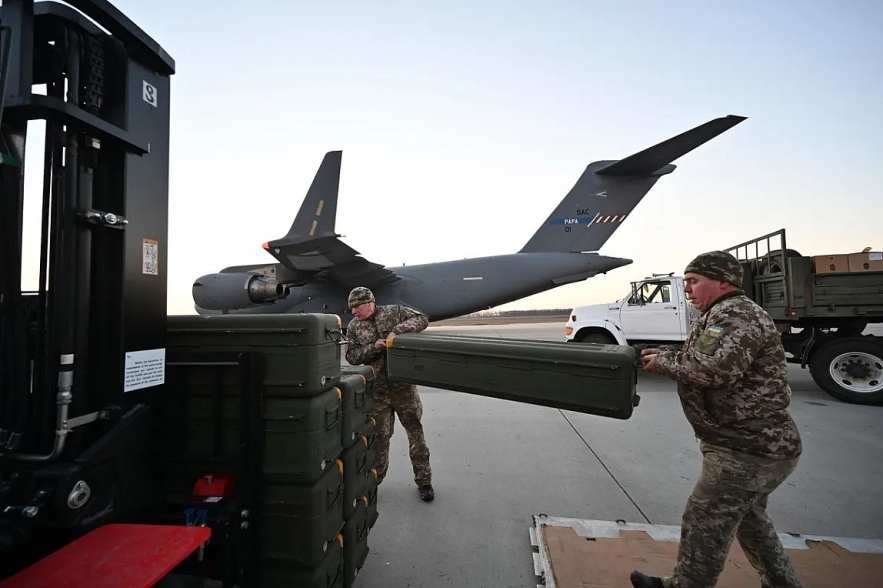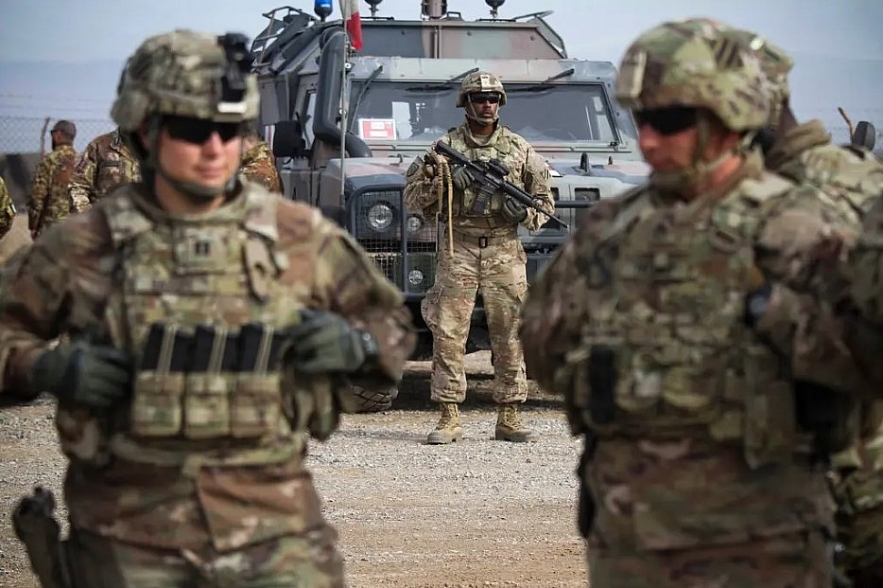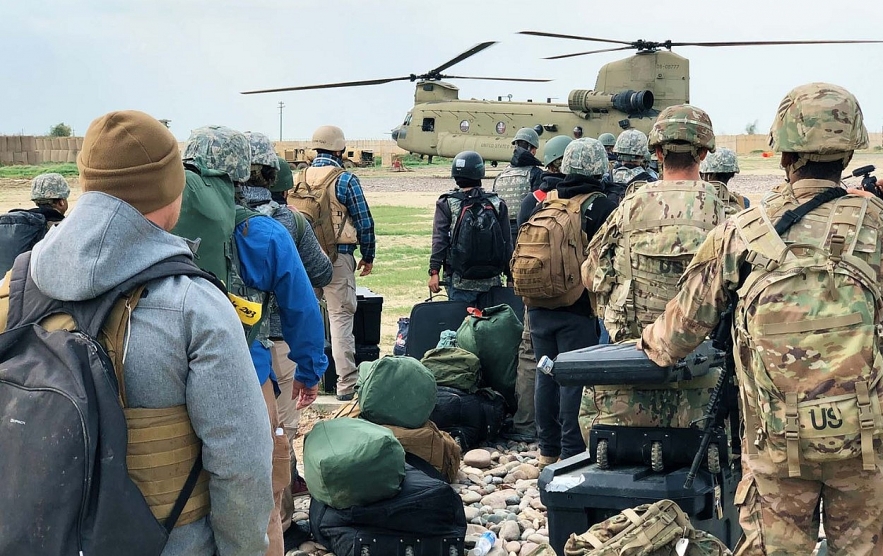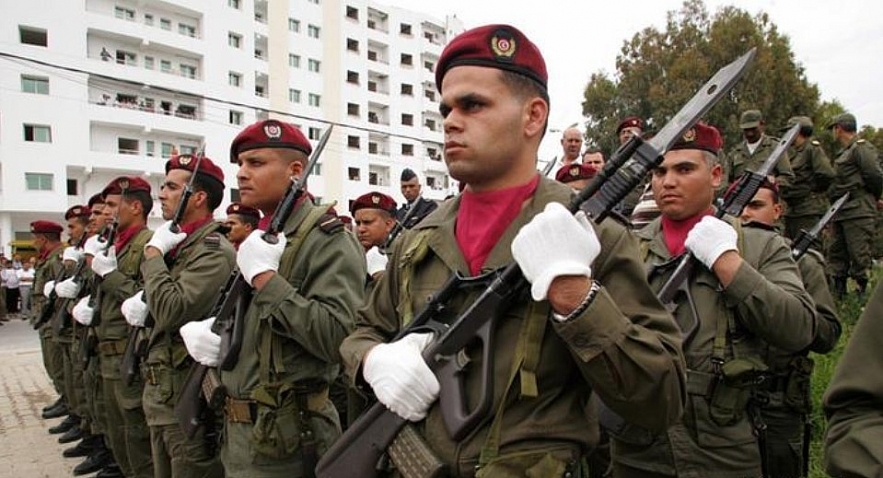Top 10 Countries Get The Most Military Aid From USA
 |
| Countries received the most US military aids. Photo: knowinsiders. |
| Table of Content |
What are countries received the most US military aids?
Military aid is one of the two main types of foreign aid spending, along with economic aid. Military aid can take the form of funding for a nation's armed forces' training or salary, as well as the delivery of arms, vehicles, and other military hardware.
Data on military aid may not include all Defense Department spending due to reporting restrictions. This includes US military assistance that is classified for national security reasons, as well as funding for Israel's missile defense system. Since 1947, the US government has provided nearly $1 trillion in military aid to other countries, inflation-adjusted. The top 10 nations from which the US provided the most military aid are listed below:
1. Ukraine: $9.8 billion
2. Israel: $3.3 billion
3. Afghanistan: $2.76 billion
4. Egypt: $1.3 billion
5. Iraq: $548.1 million
6. Jordan: $504 million
7. Colombia: $272.9 million
8. Somalia: $94.1 million
9. Lebanon: $71 million
10. Tunisia: $52.4 million
*****
How much military aid does the US provide to other nations?
157 different countries received $11.6 billion in military assistance from the US in 2020, according to data from the State Department and the US Agency for International Development.[1] Less than 2% of the $683 billion spent that year on national defense was represented by the contributions. Since 2004, the US had given less military aid than this.
Military aid is one of the two main types of foreign aid spending, along with economic aid. Foreign aid expenditures in the US in 2020 totaled $51.1 billion, or 1% of the total federal budget. In 2020, 23% of funding for foreign aid went toward military assistance.
Military aid can take the form of funding for a nation's armed forces' training or salary, as well as the delivery of arms, vehicles, and other military hardware.
Data on military aid may not include all Defense Department spending due to reporting restrictions. This includes US military assistance that is classified for national security reasons, as well as funding for Israel's missile defense system.
Since 1947, the US government has provided nearly $1 trillion in military aid to other countries, inflation-adjusted.
Top 10 countries received the most US military aids
1. Ukraine: $9.8 billion
On May 21, President Biden signed the $40 billion in new aid to Ukraine that was approved by the Senate 86 to 11. The bill, which was approved by the House of Representatives earlier this month, raises American expenditures on the conflict to more than $100 million per day, according to defense experts, according to npr.org. The bill is the most recent step in a bipartisan effort to support Ukraine in fending off Russia's invasion without enlisting American troops in a deadly global conflict. These investments have been concentrated on providing direct military assistance, humanitarian aid, and funding to assist in fending off cyberattacks and Russian disinformation campaigns.
Vox.com reports that according to a recent list released by the Department of Defense, the US has sent everything from Javelin anti-tank missiles to Switchblade drones, artillery, and body armor, and increasingly some high-tech equipment like laser-guided rocket systems, surveillance radar, and Mi-17 helicopters. And it's really showing on the battlefield, where Russia's eastern offensive is faltering.
The amount could be even higher because the congressional appropriation for Ukraine and NATO allies includes $4 billion for foreign military financing, which uses US taxpayer money to finance the purchase of US weapons by other nations.
The $8.7 billion provided by Congress to restock US arsenals will likely cover a large portion of the weapons that have been sent to Ukraine since the beginning of the Russian invasion in February. In order to ensure that emergency weapons could reach the nation as soon as possible, the Biden administration sent those under a policy known as the drawdown authority.
 |
| Servicemembers in the Ukrainian military move US-made Stinger missiles, a portable air-defense system, and other military assistance shipped from Lithuania to Kyiv on February 13, 2022. Sergei Supinsky/AFP via Getty Images |
The Biden administration has portrayed Ukraine's tenacity in defying Russia as a fight between freedom and tyranny that is worthwhile supporting. According to Jessica Lewis, the State Department's assistant secretary for political-military affairs, the security assistance is assisting in "supporting Ukraine's ability to protect its sovereignty and territorial integrity and to stand against Russia's brutal and unprovoked assault."
How Strong Is The Ukrainian Army - 22nd Strongest Militaries in The World
2. Israel: $3.3 billion
According to everycrsreport.com, Israel is the country that receives the most foreign military aid from the United States. The President's request for Israel would account for roughly 57% of the total FMF funding requested globally for FY2020. About 18% of Israel's overall defense budget is allocated to Israel each year in the form of FMF grants. Israel has one of the highest defense spending ratios in the world (4.3% in 2018), ranking among the highest in the world.
Israel has over the years built up one of the most sophisticated militaries in the world thanks to US aid, which enabled them to buy high-tech weapons from the US.
For instance, the BBC reported that Israel has purchased 50 missile-capable F-35 combat aircraft, of which 27 have already been delivered at a cost of about $100 million (£70.4 million) each.
Additionally, Israel purchased eight Boeing 'Pegasus' KC-46A aircraft last year for an estimated $2.4 billion (£1.7 billion). These have the ability to refuel aircraft like the F-35 in midair.
Israel has also invested millions working with the US to create military technology, such as a system to find tunnels used to infiltrate Israel.
The Israeli government makes significant investments in military hardware and training, using the assistance to make up for the fact that it is smaller than many other regional powers.
Israel has received the most foreign aid from the US overall since World War Two. Israel was the second-highest recipient of US foreign aid after Afghanistan in 2019, the most recent year for which fully reported data is available, according to USAID.
Why does the US give Israel so much aid?There are many reasons why the US supports Israel so heavily, including historical obligations stemming from US support for the establishment of the Jewish state in 1948. Additionally, the US views Israel as a crucial ally in the Middle East, with whom it shares values and goals with. US foreign aid has been a significant factor in strengthening and cementing these ties, according to the US Congressional Research Service. "Many lawmakers and US officials have long viewed Israel as a crucial partner in the region." According to the department responsible for providing foreign aid to the US government, "US assistance helps ensure that Israel maintains its Qualitative Military Edge (QME) over potential regional threats." It also reads, "US assistance... is aimed at ensuring that Israel is sufficiently secure to take the historic steps necessary to reach a peace agreement with the Palestinians and for comprehensive regional peace." |
3. Afghanistan: $2.76 billion
 |
| United States troops at a training station in Herat, Afghanistan, this month. The plan would shift American operations from training to counterterrorism strikes.Credit...Jalil Rezayee/EPA, via Shutterstock |
Between 2001 and 2020, the US government gave Afghanistan nearly $73 billion in military aid, which is nearly 20 times more than Afghanistan's own military spending. After it was announced in April 2021 that NATO's Resolute Support Mission would end, the Taliban took control of Kabul in just over four months despite the USA having given the ANDSF equipment, training, services, funding for salaries, infrastructure, and more.
President Biden predicted that the cost of the war in Afghanistan had likely exceeded US$2 trillion after the final withdrawal of US forces from Afghanistan. Although US military operations accounted for the majority of the estimated expenditure, the USA also heavily invested in reconstruction efforts.
SIPRI views five budget lines—out of the total amount of reported US security-related reconstruction spending in Afghanistan—as military assistance. The Department of State (DOS) and the Department of Defense (DOD) are the two sources for these. These five funds made payments to Afghanistan totaling $72.7 billion in current dollars (or $81.6 billion in constant 2019 dollars) between 2001 and 2020.
A separate Train and Equip Fund ($440 million in current dollars) and the Afghanistan Security Forces Fund (ASFF; $71.7 billion in current dollars), which were both established by the US Congress, provided the majority (99.2%) of this military assistance. Equipment, supplies, services, training, funding for salaries, facility and infrastructure repair, renovation, and construction were all provided by the two funds together to the ANDSF.
The Department of State provided $564 million in current dollars worth of military assistance to Afghanistan through the International Military Education and Training (IMET), Foreign Military Finance (FMF), and Peacekeeping Operations (PKO) funds.
The initial level of US military assistance to Afghanistan was very low; between 2001 and 2005, the combined DOD and DOS budget was less than $1 billion per year. Annual aid expenditures increased to $7.4 billion by 2008. This increase in assistance occurred at the same time that the US started to contribute a sizable number of troops to multilateral peace operations, indicating increased US involvement in Afghanistan. However, due to the temporary effects of the global financial and economic crisis, aid to Afghanistan fell to $5.2 billion by 2010.
| The U.S. spent approximately $2 trillion in its longest war. Over 170,000 lives were lost in 20 years. However, despite massive efforts to build up the Afghan military and prop up the government, it took only a few weeks for the government to fall and the Taliban to take over the country as U.S. forces withdrew. |
4. Egypt: $1.3 billion
Following Egypt's independence from its status as a protectorate under the United Kingdom, diplomatic ties between the two countries were established in 1922. Based on shared concerns for regional security, economic opportunity, and peace and stability in the Middle East, the United States and Egypt have a close relationship. The strategic partnership is further strengthened by the close ties and assistance in the cultural and educational fields. The main goal of American policy is to support an Egypt that is stable, prosperous, and where the government upholds the fundamental rights of its people while also providing for the needs of a sizable and expanding population.
The development of Egypt's economy and military, as well as the strengthening of the strategic alliance between the United States and Egypt and regional stability, have all benefited from U.S. assistance to Egypt. According to state.gov, the United States has given Egypt more than $50 billion in military aid and $30 billion in economic assistance since 1978.
The Biden administration decided to repurpose $130 million in Fiscal Year (FY) 2020 Foreign Military Financing (FMF), which was originally allocated for the brutal government of Egyptian President Abdel Fattah al-Sisi, after the January 30 deadline, according to freedomhouse.org. Since the middle of September of last year, the United States had withheld this military assistance pending the fulfillment by the Egyptian government of two modest human rights requirements: ending the wrongful detention of or dropping the charges against 16 Egyptians who were politically targeted by al-Sisi's administration and conclusively ending the ten-year-old Case 173 targeting independent civil society.
The undersigned organizations applaud the Biden administration's decision to fully reprogram this assistance in light of the Egyptian government's egregious failure to comply with the minimal requirements set forth by the administration. Respecting the terms of the aid demonstrates the value of human rights in the two countries' bilateral relations. However, the powerful message that could have been sent by reprogramming assistance has been undermined by moving forward with billions of dollars' worth of security assistance just days before the decision.
Reprogramming the withheld funds could have given the Egyptian government significant leverage to uphold fundamental human rights standards; however, the Biden administration egregiously undermined its decision by announcing more than $2.5 billion in arms sales to Egypt and obligating $1 billion in FY2021 FMF just days earlier. The very purpose of reprogramming the funds is undermined by denying the brutal government of President al-Sisi $130 million while continuing with weapons deals and military aid worth nearly $30 million more. By doing this, the administration also wasted an opportunity to make good on its pledge to "center" human rights in its relations with Egypt.
Read More: Top 10 Strongest Air Forces of the World in 2022/2023: India Overtakes China
5. Iraq: $548.1 million
Israel is the largest cumulative recipient of U.S. foreign assistance since World War II. To date, the United States has provided Israel $142.3 billion (current, or noninflation-adjusted, dollars) in bilateral assistance and missile defense funding. Almost all U.S. bilateral aid to Israel is in the form of military assistance. In 2016, the U.S. and Israeli governments signed a 10-year Memorandum of Understanding (MOU) on military aid, covering FY2019 to FY2028. Under the terms of the MOU, the United States pledges (pending congressional appropriation) to provide Israel $38 billion in military aid
($33 billion in Foreign Military Financing or FMF grants plus $5 billion in missile defense appropriations). This MOU replaced a previous $30 billion 10-year agreement, which ran through FY2018.
According to Congressional Research Service, Israel is the largest recipient of FMF. For FY2021, the President’s request for Israel would encompass approximately 59% of total requested FMF funding worldwide. Israel uses most FMF to finance the procurement of advanced U.S. weapons systems. In March 2020, the Defense Security Cooperation Agency (DSCA) notified Congress of a planned sale to Israel of eight KC-46A Boeing “Pegasus” aircraft for an estimated $2.4 billion. According to Boeing, the KC-46A Pegasus is a multirole tanker (can carry passengers, fuel, and equipment) that can refuel all U.S. and allied military aircraft.
The Israeli Air Force’s current fleet of tankers was originally procured in the 1970s, and it is anticipated that Israel will be able to use the KC-46A to refuel its F-35 fighters. Israel is the first international operator of the F-35 Joint Strike Fighter, the Department of Defense’s fifth-generation stealth aircraft considered to be the most technologically advanced fighter jet ever made. After Japan, Israel will become the second foreign user of the KC-46A.
 |
| Photo: rudaw.net. |
6. Jordan: $504 million
Another major recipient of American aid abroad is the Hashemite Kingdom of Jordan. The most recent MOU on foreign aid between the US and Jordan was signed in 2018, similar to that between Israel and the US. The MOU, which is the third such agreement between the United States and Jordan, commits the country to spending $6.375 billion (FY2018-FY2022) on bilateral foreign aid over a five-year period (pending congressional appropriation). The main purpose of U.S. military assistance is to help the Jordanian military acquire and maintain conventional weapons systems that are American in origin. The FMF managed by the State Department supports the multi-year (typically five-year) procurement plans of the Jordanian Armed Forces, whereas the security assistance managed by the DOD supports ad hoc defense systems to address emerging threats.
According to swfinstitute.org, the United States is Jordan's top bilateral donor, giving more than US$ 1.5 billion in 2020. This includes US$ 1.082 billion that the U.S. Congress appropriated to Jordan through USAID in the 2020 fiscal year budget and US$ 425 million in Foreign Military Financing funds from the State Department.
Despite being one of the Middle East's most stable and peaceful nations, Jordan is currently struggling economically as a result of the COVID pandemic and the Syrian refugee crisis. Over a million Syrians have been housed in Jordan and Lebanon, respectively. The State Department stated that "preservation of border integrity and regional stability" are the two main objectives of U.S. military assistance to the kingdom, as quoted by US News.
7. Colombia: $272.9 million
 |
| Photo: harvardpolitics.com. |
Colombia, a close ally of the United States in Latin America, has experienced internal armed conflict for more than 50 years. The United States and Colombia established a close relationship to address the nation's part in the production of illegal drugs. Plan Colombia, a program with a dual focus on counterterrorism and counternarcotics, set the stage for a reliable security alliance that has lasted for more than 20 years. The Revolutionary Armed Forces of Colombia (FARC), then the largest leftist guerrilla group in the nation, and President Juan Manuel Santos (2010-2018) reached a peace agreement, which the US has also backed in its implementation.
Under Plan Colombia, the United States significantly supported Colombian-led counternarcotics programs for drug eradication and interdiction with funding, technical support, and equipment. Despite the 2012 expiration of Plan Colombia, American assistance is still vital to Colombia's armed forces, with the majority of it coming from the Bureau of International Narcotics and Law Enforcement (INL) of the U.S. State Department.
The U.S. Department of Defense provides equipment and training to the Colombian military and police through military assistance programs through the Foreign Military Sales Trust Fund. The U.S. State Department and the programs it oversees, like the INL program, are additional sources of funding. Since 1990, INL has acted as Colombia's primary funding source for equipment purchases through private military consulting companies. These businesses conduct business using a system of open, competitive bidding that is primarily focused on assisting the National Police with drug eradication and interdiction operations.
Regarding the purchase of military hardware, the United States and Colombia continue to have a special relationship. Nevertheless, rivals from France, Korea, Canada, Switzerland, Russia, Israel, and the United Kingdom are also significant players and are gaining market share steadily. The Colombian military favors relationships, quality, warranties, interoperability, and equipment familiarity while using standardized tools. Official estimates indicate that in 2020, the U.S. import market share represented 37% of Colombia's total imports of military hardware (France has 47% and Korea has 5%).
The Colombian military upholds high standards for its equipment, as trade.gov reported, which has historically been a great opportunity for American exporters. However, due to increased foreign manufacturer competition and corruption in the procurement process, the United States may eventually lose market share. In some industries, like the specialized fabrics used in uniforms, which are increasingly sourced from China, U.S.-made fabrics are already losing market share.
8. Somalia: $94.1 million
After Somalia's constituent parts gained independence from British and Italian rule, respectively, the United States established diplomatic ties with Somalia in 1960. Following a coup in 1969, Somalia was put under military rule that was ideologically and economically reliant on the Soviet Union. Following a conflict with Ethiopia in the 1970s, Somalia started looking to the West, including the United States, for financial assistance, military aid, and political support. The central government of Somalia was overthrown in 1991 as a result of the outbreak of a civil war in the 1980s.
AMISOM has received assistance from the US State Department and military in terms of security forces. The US has invested almost $2 billion in bilateral and multilateral security aid for AMISOM's contributing nations since 2006. This has included US contributions to the UN Support Office for Somalia (UNSOS), which since 2009 has given AMISOM logistical support, as well as training, equipment, and advisory programs that are frequently carried out by contractor companies.
On the military front, several hundred US troops are now routinely stationed in Somalia, according to chathamhouse.org. AFRICOM, US Army Africa, the Combined Joint Task Force-Horn of Africa, Joint Special Operations Command, and a Military Coordination Cell based in Mogadishu since at least 2014 are some of the commands from which they operate. The Obama administration took steps in 2016 to increase US military activity in Somalia. In areas of Somalia that were not formally referred to as "areas of active hostilities," the main goal was to protect US, AU, and some Somali security personnel. In March 2017, the Trump administration went a step further by designating a portion of Somalia as a "area of active hostilities," giving US military commanders more freedom to choose targets and give the go-ahead for airstrikes. US soldiers have continued a number of more established activities under these expanded powers.
| There have not been elections under universal suffrage in Somalia since 1967, except in Somaliland, which has held a number of one-person-one-vote presidential and parliamentary elections. |
9. Lebanon: $71 million
 |
| Photo: aa.com.tr. |
Security support for the Lebanese Armed Forces (LAF) is referred to by the US State Department as "a key component" of US policy toward the Middle Eastern nation, according to shephardmedia.com.
Military grants totaling $216 million in FY2020 alone and $1.83 billion in active FMS proposals make up the US's cumulative investment in the LAF of more than $2.5 billion since 2006. HMMWVs, Huey II helicopters, AGM-114 Hellfire air-to-surface missiles, and TOW 2A anti-tank missiles are a few examples given by the State Department. The Lebanese Air Force's acquisition of six A-29 Super Tucanos in June 2018 was one notable FMS delivery in recent years.
According to Reuters, the United States intends to redirect $67 million in military aid intended for Lebanon's armed forces to help military personnel as the nation struggles with a financial crisis.
The State Department intends to add "livelihood support" for Lebanese military personnel to the previously appropriated foreign military funding for Lebanon, according to a notification sent to Congress, citing both economic and social unrest.
The American assistance, according to The Nation News, will be used to support "shared priorities in counterterrorism, border security, and defense institution building."
The US announcement comes after Gen. Aoun issued a warning in March, warning that the military requires immediate assistance lest soldiers "go hungry" as Lebanon struggles with the economic crisis. His warning caused Lebanon's allies to worry that the army might be overworked given the presence of militant groups operating in neighboring Syria and paramilitary organizations like the Iran-backed Hezbollah.
The Lebanese Army declared in 2021 that it would stop providing meat to its troops because it was too expensive. In the past 18 months, the value of the Lebanese pound has decreased by more than 80%, drastically reducing the purchasing power of Lebanese citizens, including military personnel, at a time of social and political unrest.
The House Foreign Affairs Committee warned that the financial hardship of Lebanese soldiers "threatens to lead to desertions, degradation of the force and further civil conflict" in a letter delivered to US Secretary of State Antony Blinken on Tuesday.
10. Tunisia: $52.4 million
 |
| Photo: dw.com. |
State.gov claims that after Tunisia gained independence from France in 1956, the United States was the first major power to recognize its sovereignty and to establish diplomatic ties with the country. A democratic transition process started on January 14, 2011, and is still in progress. In elections that were regarded as free and fair, a Constituent Assembly tasked with drafting a new constitution was chosen in October 2011. Strengthening the nation's fledgling democratic institutions, promoting positive public engagement in the political process, creating jobs, particularly for young people, women, and college graduates, combating the threat of transnational terrorism and spillover from conflicts in neighboring countries, and managing increased demands on the national security forces are the current challenges facing Tunisia.
The United States has committed more than $1.4 billion to aiding Tunisia's transition since the revolution of January 2011. The main areas of focus for American aid to Tunisia are ensuring and enhancing internal and external security, advancing democratic norms and good governance, and fostering long-term economic growth.
A five-year bilateral development objective agreement between the US and Tunisia was signed in 2019 and calls for USAID to contribute up to $335 million to boost private sector employment and democratic consolidation.
The Arab Spring arrived as a result of the Tunisian revolution that took place in the winter of 2010–2011. The State Department claims that the U.S. made it a priority "to help Tunisia provide a secure environment conducive to the development of democratic institutions and practices," including aiding counterterrorism initiatives. Biden now wants to cut military aid to the nation in half because the country has taken a more authoritarian turn since President Kais Saied suspended parliament last summer.
| How much the US spends on military aid and who receives it are likely to change in light of the 2021 US withdrawal from Afghanistan and the 2022 Russian invasion of Ukraine. Ukraine has benefited from US military assistance worth $1.7 billion since Russia annexed Crimea from Ukraine in 2014. The US provided Ukraine with $3.7 billion in military assistance following Russia's second invasion of the country in February 2022. President Joe Biden asked Congress for permission to spend an additional $15 billion on military expenditures in late April 2022, primarily for Ukraine and the nearby nations affected by the conflict. |
 Top 10 Countries With Highest Job Opportunities to Start A Career in 2022/2023 Top 10 Countries With Highest Job Opportunities to Start A Career in 2022/2023 If you are looking for a new job or want to relocate to a new country, consider one of these ten countries with the highest ... |
 Top 10 Countries With Tallest People in the World Top 10 Countries With Tallest People in the World According to World Population Review’s 2022 report on the average height by countries around the globe, the Netherlands is the country will tallest people in ... |
 Top 10 Countries Have The Highest Minimum Wage in the World Top 10 Countries Have The Highest Minimum Wage in the World The minimum wage (salary) has a great effect on people's lives, lifestyles, and the economy of a country. Here are the top 10 countries with ... |























